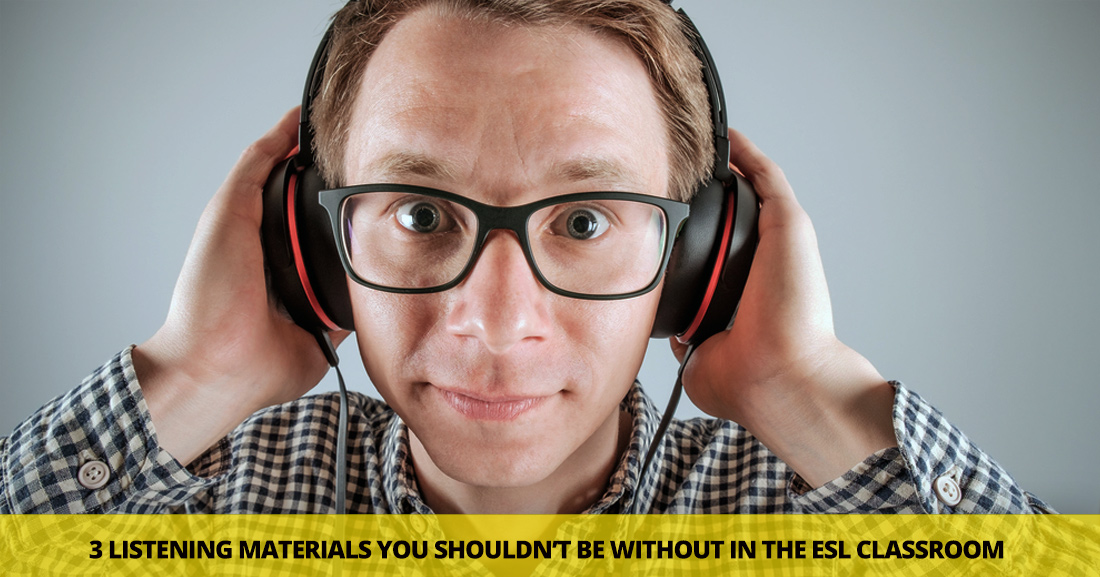All Ears Up Here: Listening Practice for Every Level


They’re great, don’t get me wrong. But sometimes I can’t help but wonder, if these recorded ESL texts are all my students ever listen to, how ready will they be for listening in the real world? After all, these prefab sound bites use limited vocabulary, have actors for the voice parts, show almost no accent, and can be rewound and replayed till the sun goes down. That’s what put me on my search for real life listening activities.
Situations and language that my students will encounter in the real world. And once I started thinking about it, I started incorporating these listening activities into my plans for class. You could say these activities were challenging for my students. I like to think they got them out of their ESL materials bubble. In fact, including real world materials, otherwise known as realia, is important for ESL classes and an area in which most ESL teachers could use some encouragement. Hence these three ideas for bringing real life listening into the ESL classroom.
Some can be used for all levels of students. Others may be better for higher level students or those pursuing certain directions after their English studies. No matter, though, if you take the time to look you’ll probably find something that your ESL student can benefit from. So take a look, or should I say take a listen and see if you’re inspired to include real life listening materials in your ESL class.
You don’t have to be teaching a reading class to know how valuable books are for ESL students. In this case, audio books. Their popularity is on the rise, especially with the ease of access offered by Audible and Overdrive. You can do just about any reading comprehension activity as a listening comprehension activity when you use audio books. And the great thing is they are appropriate for all levels of ESL students depending on the material, the complexity of the writing, and who the voice actor is.
You can choose simpler books with very neutral accents for lower level students. Or you can choose more complicated text with readers who voice different parts with different accents and styles of speech. Some of my favorite audiobooks are the Harry Potter Series (though they are British English) as well as The Help and Walk Two Moons, which will challenge your students with nonstandard English accents.
If you use audiobooks in class, don’t feel like you have to play it from start to finish. Try playing a portion of an audiobook for your class and asking them to summarize what they heard or put its events in sequence. Have students listen for specific vocabulary or character points of view. You can even give simple or complex comprehension questions just like you would with a written text.
If your students are anything like mine, many of them will pursue higher education in English after they finish their studies in your program. For that reason, it’s great when you can include college lectures in your ESL classroom as listening exercises. Those lectures are exactly what they will encounter when they attend college, so get them ready by playing lectures for your students now.
YouTube has a myriad of lectures available for free. All you have to do is search “college lecture” along with the topic you want for the lecture (if you really want to motivate some tough to motivate students try showing them a freshman English lecture) and several choices will pop up.
Before you watch the video in class, spend a few minutes talking about how to take notes in a lecture, then press play and throw your students in the deep end. Have them take notes while they listen, and then review the notes they took after they have finished watching the lecture. And to make the experience as realistic as possible, only let them listen once.
After watching, point out the important information they should have noted as well what information you may have chosen to leave out of your notes. Follow up with a short quiz on the content letting them use their notes as they take the quiz. This exercise will be challenging, and that’s why it’s best reserved for upper intermediate and advanced students.
Podcasts are more popular today than ever. They are easy to subscribe to, entertaining and informative, and often free. Many people use podcasts to pass the time or learn more about subjects that interest them. That is why they make great listening material for ESL students.
Anyone can publish a podcast, and that means when you use them in your class, your students will get exposure to many different styles of speech, including accents and levels of formality. For example, a podcast on hunting in the Alaskan wild would be very different from a podcast of horror stories. Choose one or more you think might be interesting for your students and get the technology you will need to play it in class. Most likely, you can download a podcast on your phone, and you’ll only need a portable speaker to make the recording accessible for everyone in your class.
If you choose a how to podcast, try having students note the steps in the process and then write them up as formal instructions. If you listen to a story, have students summarize the main events or talk about the problems the characters faced and how they tackled them. Or let each student choose a podcast of their own liking and then present the information they learned to the class in a presentation.
The more often you use materials like these the better your students will get at listening to them. So don’t lose heart if your students struggle at first. You know what they say about that. Just try, try again.